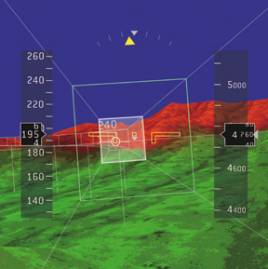
Flight Science & Technology Research Group
Prospective Skyguides - Developing Guidelines for Pilot Vision Aids
Department Home
Page
Courses
Simulation
Facilities
Feedback: mdw@liv.ac.uk
Limited visibility is ‘the single most critical factor affecting safety of worldwide aviation operation. Thirty percent of all fatal accidents worldwide are a result of impacts into terrain or obstacles the pilot did not see’ (source: US Aviation Safety Programme).
 Many natural species rely
primarily on optical information to follow a safe path through the
cluttered environment near the Earth’s surface.
In a similar way, pilots use visual perception to create a
mental model of where their aircraft will be in the future to fly a
safe path through their surroundings.
The reliability of this model is particularly critical when
flying close to the ground or near to obstacles.
In a good visual environment, the pilot is usually able to
pick up sufficient information from the available visual scene.
As the visual environment degrades, for example, due to
adverse weather conditions, the available visual information
becomes less reliable. To
counteract this degradation, the pilot requires some form of
guidance vision aid.
Many natural species rely
primarily on optical information to follow a safe path through the
cluttered environment near the Earth’s surface.
In a similar way, pilots use visual perception to create a
mental model of where their aircraft will be in the future to fly a
safe path through their surroundings.
The reliability of this model is particularly critical when
flying close to the ground or near to obstacles.
In a good visual environment, the pilot is usually able to
pick up sufficient information from the available visual scene.
As the visual environment degrades, for example, due to
adverse weather conditions, the available visual information
becomes less reliable. To
counteract this degradation, the pilot requires some form of
guidance vision aid.
(Image
courtesy of National Defense, Feb 2003)
To provide such a guidance vision aid, a complete reconstruction of the natural world from active/passive sensors coupled with terrain databases would be an arduous task in the medium term. This begs the question: what is the minimum necessary and sufficient visual information required by a pilot to develop a reliable mental model, rather than a dangerous illusion, that will allow safe flight through the surrounding environment ? This research aims to answer this, and related questions by:
-
Establishing a coherent engineering basis for the design of pilot aids that will support flight in degraded visual conditions, particularly when close to the ground. The intended use of such aids would be for civil fixed and rotary wing aircraft.
-
Constructing and evaluating synthetic displays that recover the visual cues necessary to allow flight in degraded visual conditions for a range of manoeuvres.
To
bring this work to practical fruition, the project industrial
partner, BAE Systems, will gradually apply technology and
certification constraints to the research.
Members: